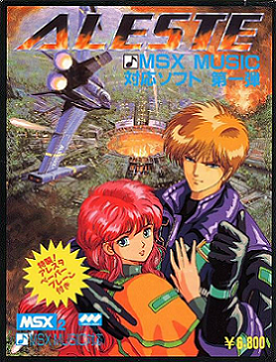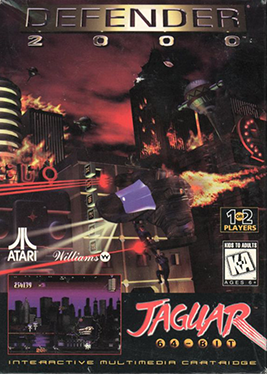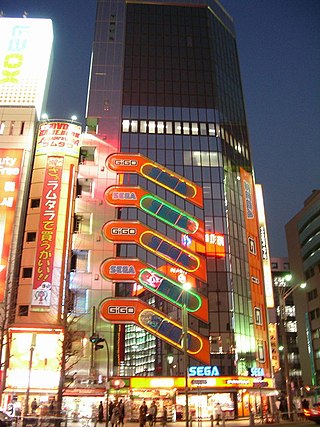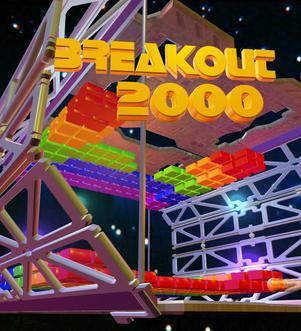
Quake III Arena is a 1999 multiplayer-focused first-person shooter developed by id Software. The third installment of the Quake series, Arena differs from previous games by excluding a story-based single-player mode and focusing primarily on multiplayer gameplay. The single-player mode is played against computer-controlled bots. It features music composed by Sonic Mayhem and Front Line Assembly founder Bill Leeb.

A platformer is a sub-genre of action video games in which the core objective is to move the player character between points in an environment. Platform games are characterized by levels with uneven terrain and suspended platforms of varying height that require jumping and climbing to traverse. Other acrobatic maneuvers may factor into the gameplay, such as swinging from vines or grappling hooks, jumping off walls, gliding through the air, or bouncing from springboards or trampolines.

The history of video games began in the 1950s and 1960s as computer scientists began designing simple games and simulations on minicomputers and mainframes. Spacewar! was developed by Massachusetts Institute of Technology (MIT) student hobbyists in 1962 as one of the first such games on a video display. The first consumer video game hardware was released in the early 1970s. The first home video game console was the Magnavox Odyssey, and the first arcade video games were Computer Space and Pong. After its home console conversions, numerous companies sprang up to capture Pong's success in both the arcade and the home by cloning the game, causing a series of boom and bust cycles due to oversaturation and lack of innovation.
The fifth generation era refers to computer and video games, video game consoles, and handheld gaming consoles dating from approximately October 4, 1993, to March 23, 2006. The best-selling home console was the Sony PlayStation, followed by the Nintendo 64 and Sega Saturn. The PlayStation also had a redesigned version, the PSone, which was launched on July 7, 2000.
Free look describes the ability to move a mouse, joystick, analogue stick, or D-pad to rotate the player character's view in video games. It is almost always used for 3D game engines, and has been included on role-playing video games, real-time strategy games, third-person shooters, first-person shooters, racing games, and flight simulators. Free look is nearly universal in modern games, but it was one of the significant technical breakthroughs of mid-1990s first-person perspective games. Many modern console games dedicate one of the several analogue sticks on the gamepad entirely to rotating the view, where as some older console games, when gamepads usually had fewer or only a single D-pad or analogue stick, had a feature where the single D-pad or analogue stick would move the view instead of the character whilst the player held down another button at the same time, often labelled in game as the "look button".
1996 saw many sequels and prequels in video games, such as Super Mario 64, Duke Nukem 3D, Street Fighter Alpha 2, Super Mario RPG, King's Field III, Virtua Fighter 3, along with new titles such as Blazing Heroes, NiGHTS into Dreams..., Crash Bandicoot, Pokémon Red/Green/Blue, Resident Evil, Dead or Alive, Soul Edge, Quake and Tomb Raider.

Aleste (アレスタ) is a vertically scrolling shooter developed by Compile, originally published by Sega in 1988 for the Master System and then by CP Communications for the MSX2. The Master System version was released outside Japan as Power Strike. The game spawned the Aleste and Power Strike franchises.
Virtua Fighter is a series of fighting games created by Sega AM2 and designer Yu Suzuki. The original Virtua Fighter was released in December 1993 and has received four main sequels and several spin-offs. The highly influential first Virtua Fighter game is widely recognized as the first 3D fighting game released. The latest mainline release was Virtua Fighter 5 in 2006; this version has since been continuously updated.
A side-scrolling video game is a game viewed from a side-view camera angle where the screen follows the player as they move left or right. The jump from single-screen or flip-screen graphics to scrolling graphics during the golden age of arcade games was a pivotal leap in game design, comparable to the move to 3D graphics during the fifth generation.

Defender 2000 is a 1996 scrolling shooter video game developed by Llamasoft and published by Atari Corporation for the Atari Jaguar. Part of Atari's 2000 series of arcade game revivals, it is an update of Eugene Jarvis' arcade game Defender (1981). The premise takes place in a future where the Alpha Promixian empire attack mining settlements on distant resource planets. Gameplay is divided into three modes, with the player acting as part of the System Defense Team commanding the Threshold ship to defeat waves of invading aliens while protecting humans.

In video games, first-person is any graphical perspective rendered from the viewpoint of the player character, or from the inside of a device or vehicle controlled by the player character. It is one of two perspectives used in the vast majority of video games, with the other being third-person, the graphical perspective from outside of any character ; some games such as interactive fiction do not belong to either format.
Atari, Inc. is an American video gaming company based in New York City, and a subsidiary of the Atari SA holding company. It is the main entity serving the commercial Atari brand globally since 2003. The company currently publishes games based on retro Atari franchises as well as some new content, and also produces the new Atari 2600+ console. In the past it produced titles including Neverwinter Nights, Driver 3, Fahrenheit, RollerCoaster Tycoon 3 and Test Drive Unlimited.
Light-gun shooter, also called light-gun game or simply gun game, is a shooter video game genre in which the primary design element is to simulate a shooting gallery by having the player aiming and discharging a gun-shaped controller at a screen. Light-gun shooters revolve around the protagonist shooting virtual targets, either antagonists or inanimate objects, and generally feature action or horror themes and some may employ a humorous, parodic treatment of these conventions. These games typically feature "on-rails" movement, which gives the player control only over aiming; the protagonist's other movements are determined by the game. Games featuring this device are sometimes termed "rail shooters", though this term is also applied to games of other genres in which "on-rails" movement is a feature. Some, particularly later, games give the player greater control over movement and in still others the protagonist does not move at all. On home computer conversions of light-gun shooters, mouse has been often an optional or non-optional replacement for a light gun.
The 1990s was the third decade in the industry's history. It was a decade of marked innovation in video gaming. It was a decade of transition from sprite-based graphics to full-fledged 3D graphics and it gave rise to several genres of video games including, but not limited to, the first-person shooter, real-time strategy, survival horror, and MMO. Arcade games, although still very popular in the early 1990s, began to decline as home consoles became more common. The fourth and fifth generation of video game consoles went on sale, including the Sega Genesis, Super Nintendo, Sega Saturn, PlayStation, Nintendo 64, Game Boy Color and the Sega Dreamcast. Notable games released in the 1990s included Super Mario World, Sonic the Hedgehog, Street Fighter II, Mortal Kombat, Tekken 3,Doom, Wolfenstein 3D, Quake, Duke Nukem 3D, Final Fantasy VII, Unreal Tournament, Star Fox, Half-Life, Grand Theft Auto, Super Mario 64, Pokémon Red and Blue, NBA Jam,Daytona USA, GoldenEye 007, System Shock 2, Civilization,Ridge Racer, Sonic Adventure, Gran Turismo, Super Mario Kart, Pokémon Gold and Silver,Castlevania: Symphony of the Night, Super Metroid, Silent Hill, Dead or Alive 2, The Legend of Zelda: Ocarina of Time, Crash Bandicoot, Spyro The Dragon, Fallout, Metal Gear Solid, Diablo, Virtua Fighter, Tomb Raider,Sega Rally Championship, Wing Commander,Super Smash Bros, Secret of Mana,Thief: The Dark Project, Age of Empires, Nights into Dreams, Panzer Dragoon, Gunstar Heroes, EverQuest, Chrono Trigger, Battletoads, Worms, Myst, Micro Machines, Streets of Rage 2,Baldur's Gate,Donkey Kong Country, Wipeout, The Legend of Zelda: A Link to the Past, Super Mario Land 2: 6 Golden Coins,Lemmings, EarthBound, StarCraft, Banjo-Kazooie, PaRappa the Rapper, Resident Evil, Tony Hawk's Pro Skater, Soulcalibur, Command & Conquer, and Dance Dance Revolution.
Duke Nukem is a media franchise named for its main character, Duke Nukem. Created by the company Apogee Software Ltd. as a series of video games for personal computers, the series expanded to games released for various consoles by third-party developers. The first two games in the main series were 2D platformers, while the later games have been a mix of first-person and third-person shooters.

A first-person shooter (FPS) is a video game centered on gun fighting and other weapon-based combat seen from a first-person perspective, with the player experiencing the action directly through the eyes of the main character. This genre shares multiple common traits with other shooter games, and in turn falls under the action games category. Since the genre's inception, advanced 3D and pseudo-3D graphics have proven fundamental to allow a reasonable level of immersion in the game world, and this type of game helped pushing technology progressively further, challenging hardware developers worldwide to introduce numerous innovations in the field of graphics processing units. Multiplayer gaming has been an integral part of the experience, and became even more prominent with the diffusion of internet connectivity in recent years.

Video games are a major industry in Japan, and the country is considered one of the most influential in video gaming. Japanese game development is often identified with the golden age of video games and the country is home to many notable video game companies such as Nintendo, Sega, Bandai Namco Entertainment, Taito, Konami, Square Enix, Capcom, NEC, SNK, and formerly Sony Computer Entertainment. In 2022, Japan was the third largest video game market in the world after the United States and China.

Missile Command 3D is a 1995 shoot 'em up video game developed by Virtuality Entertainment and published for the Atari Jaguar. As part of Atari's 2000 series of arcade game revivals, it is an update of Dave Theurer's arcade game Missile Command (1980). The game has the player defend six cities from incoming missiles by launching anti-ballistic missiles.

Breakout 2000 is a 1996 action video game developed by MP Games and published by Telegames for the Atari Jaguar. Part of the 2000 series by Atari Corporation, it is a remake of the arcade game Breakout (1976), and one of the last officially licensed releases for the platform. Featuring a similar premise to Breakout, the player must destroy a layer of brick lines by repeatedly bouncing a ball spawned off a paddle into them and keep it in play. Gameplay modifications to the original game include a third-person perspective behind the paddle in a pseudo-3D playfield, power-ups, bonus levels, enemies, varying level designs, and multiplayer features.









